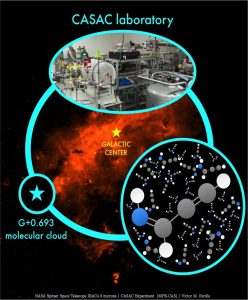
Laboratory science doesn’t always go in that direction, however. Sometimes we see things in the lab that we need to go searching for in the universe. In our ongoing search for the origins of the stuff of life, scientists have worked to understand what molecules life needs and to then see where they can be formed. One of the more fundamental molecules in life as we know it is amino acids. These molecules are primarily composed of carbon, nitrogen, oxygen, and hydrogen, and the human body uses twenty different amino acids in its various functions.
Amino acids have been observed in interstellar molecular clouds since 2003, and in a new paper accepted in Astronomy & Astrophysics, researchers have gone looking in the lab for the precursor molecules to amino acids and having found those molecules, they’ve turned around and looked in astronomical data where they have found those precursor molecules in space. The molecule in question is propargylimine, and it has been found in the molecular cloud G+0.693-027, which is located in the direction of the galactic center. The chemistry behind these molecules can take place in cold and icy areas, including on the surface of icy dust grains and even on the surface of asteroids or within comets. While we benefit from warmer production methods of these molecules, it’s intriguing to see that the building blocks of life could have been brought here rather than made here.
More Information
Max Planck Institute for Extraterrestrial Physics (MPE) press release
“Propargylimine in the Laboratory and in Space: Millimetre-wave Spectroscopy and First Detection in the ISM,” L. Bizzocchi et al., 2020, to appear in Astronomy & Astrophysics (Preprint on arxiv.org)




 Join the Crew!
Join the Crew!
 Escape Velocity Space News
Escape Velocity Space News
0 Comments